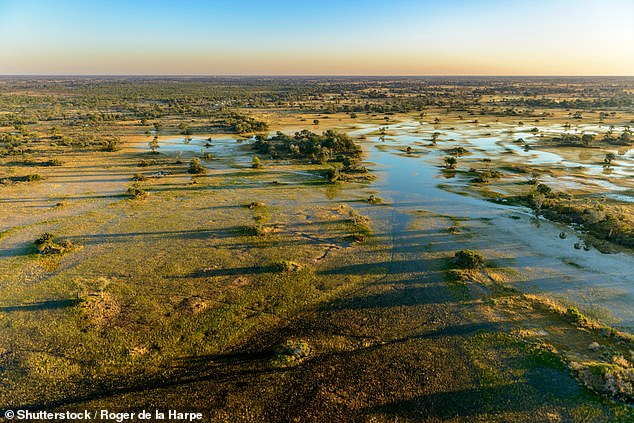Now that’s what I call a REAL walk in the park: JANE SLADE explores the Botswana bush on foot – and is warned to ‘run like hell’ when a buffalo charges

Our walking safari guide told us to stay in a straight line behind him and to stand still if we saw a big cat or elephant. ‘If you run, they’ll think you’re wild and they’ll chase you and kill you,’ he warned. ‘Stand still and they’ll retreat.’ Then he added, ‘Except the buffalo – they won’t stop, so just run like crazy.’
Although you will be much safer travelling in a large vehicle, there is nothing like exploring the bush on foot or in a canoe.
Walking safaris are not so much about spotting wildlife, but about analysing footprints, learning about trees and plants and discovering what to do if you encounter a wild animal. You soon realise why guides carry a gun.
We combined walking and canoeing with game drives in vehicles. Nowhere in Africa can you combine all three, except in the Okavango in Botswana. We went a step further and stayed in a tented camp with no fence. So if you don’t zip it up properly, you could find a baboon in your bed – or worse.
To be honest, it was a miracle we were in Africa at all. After my 66-year-old husband Neil was diagnosed with cancer two years ago and underwent two surgeries and a round of chemotherapy, he thought he wouldn’t live long enough to visit his home country again.

Jane Slade travels to the Okavango in Botswana (pictured) for a nine-day walking safari

African wonders: Okavango has the highest concentration of endangered large mammals in the world, Jane reveals. Above, a snarling lion captured by Jane’s husband, Neil
Neil was born in Zambia and spent his childhood there, fishing with his two older brothers and sister in the Zambezi, playing with their pet ducks and rabbits in their garden, and helping to care for an orphaned elephant that his animal-loving mother had briefly adopted.
Africa is in Neil’s DNA and has lured him back many times. It’s the smell of scorched earth and sage that enchants him. We’d been to many game reserves in South Africa, but never to the Okavango, Botswana’s wildlife-rich oasis with the highest concentration of endangered large mammals in the world.
During the summer months, water flows down from the highlands of Angola, creating a wetland that covers large parts of the Kalahari Desert, attracting herds of large animals and large numbers of game.
After each exciting morning ride through the bush, we escaped the heat and sat on our deck to chat about the experiences we had just had.

Jane was warned about the aggressive nature of the buffalo. “Run like hell,” was the advice if someone attacked a buffalo.
We went on boat trips in mokoros, canoes traditionally carved from hollowed-out tree trunks, and paddled out to a cheetah having lunch on an impala, blood on her face. We also saw the rare sight of two lionesses swimming.
We stayed in three camps run by Machaba Safaris during our nine day adventure in different parts of the Delta; Little Machaba, Gomoti Plains and Kiri. We wanted variety to maximise our chances of seeing as much wildlife as possible on land and in the water.
Each camp varied in size, from Little Machaba, which had only four rooms, to Kiri, which had twelve. We flew in four-seater Cessnas to small airstrips between the camps.
Machaba specialises in classic safaris based around a boma (large fire) overlooking the savannah which is illuminated at night.

Jane and Neil stayed at three camps run by Machaba Safaris. Above is Kiri, which had 12 rooms

The rare and endangered pangolin was one of many remarkable animals Jane saw during her trip (stock image)

Jane went on boat trips in mokoros, canoes traditionally carved from hollowed-out tree trunks (stock image)
The cuisine is simple. Meals with local dishes and fresh fruit and vegetables served with delicious South African wines.
Our tent was like a luxury suite with an indoor and outdoor shower, a large comfortable bed and a large terrace.
But nothing could have prepared us for the rawness of the Okavango. A hyena with a baby elephant’s foot in its mouth. A dozen lion cubs and their parents feasting on a zebra. Male lions beating up a younger male and plovers swooping down on a female cheetah and her cubs. We even saw the rarest animal of them all, the endangered pangolin.
We especially loved the evening drives, where we saw hippos and elephants against a beautiful purple and orange sunset. With a gin and tonic in hand, we enjoyed the silence. That was all Neil needed. Suddenly, his fears for his future fell away.




